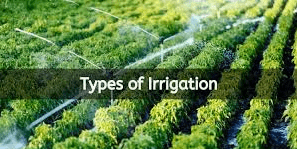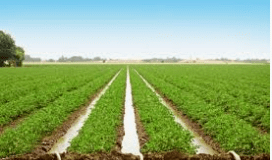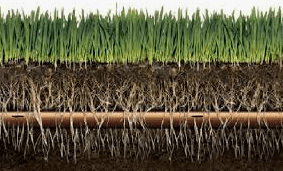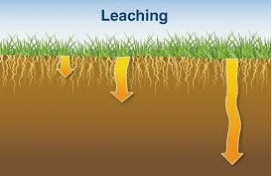Irrigation | Civil Engineering SSC JE (Technical) - Civil Engineering (CE) PDF Download
TYPES OF IRRIGATION Broadly irrigation can be classified as:
Broadly irrigation can be classified as:
(1) Surface irrigation
(2) Sub-surface irrigation
(1) Surface irrigation:
- Flow irrigation
(a) Perennial irrigation
(b) Flood irrigation - Furrow irrigation.
(2) Sub-surface irrigation:
- Natural sub-irrigation.
- Artificial sub-irrigation.
Irrigation methods:
1. Free flooding
2. Border flooding
3. Check flooding
4. Basin flooding
5. Furrow irrigation method
6. Sprinkler irrigation method
7. Drip irrigation method
Reclamation of water logged and saline soil. An agriculture land is said to be water logged, when its productivity gets affected by the high water table. If root zone of plant gets flooded with water, air will not be available to plant root zone and reduces the yield.
Plant requires nutrients like nitrate, sand these are formed by aerobic bacteria. So if air is not available, bacteria will not survive so that no food for plants and results in less yield. Due to water logging, salts will be accumulated in the root zone and these soils become saline.
Causes of Water logging:
1. Over and intensive irrigation
2. Seepage of water from adjacent high lands
3. Seepage through the canal
4. Impervious obstruction
5. Inadequate natural drainage
6. Inadequate surface drainage
7. Excessive rains
8. Submergence due to floods
9. Irregular or flat topography
Water logging Control
1. Lining of canals & water courses
2. Reducing intensity if irrigation
3. Introducing crop rotation
4. Optimum use of water
5. Providing intercepting drains
6. Provision of efficient drainage system
7. Improving the natural drainage of the area
8. Introduction of lift irrigation
EFFLORESCENCE
The phenomenon of salts coming up in solution and forming a thin (5 to 7.5 cm) crust on the surface, after the evaporation of water is called Efflorescence. Land affected by efflorescence is called Saline soil.
LEACHING In this process, the land is flooded with an adequate depth of water. The alkali salts present in the soil get dissolved in this water which percolates down to join the water table or declined away by subsurface drains.
In this process, the land is flooded with an adequate depth of water. The alkali salts present in the soil get dissolved in this water which percolates down to join the water table or declined away by subsurface drains.
- When Na2CO3 is present in the saline soil, gypsum (CaSO4) is generally added to the soil before leaching and thoroughly mixed with water.
- Na2CO3 reacts with CaSO4 forming Na2SO4 which can be leached out.
LR (leading requirement) 
Di = Cu + Dd
⇒ Dd = Di – Cu

Ci = salt content of irrigation water
Cd = salt content of leach water

ECi = electrical conductivity of irrigation water
ECd = electrical conductivity of drainage water
Crop period or Base period (B)
- The time period that elapses from the instant of its sowing to the instant of its harvesting is called the Crop period.
- The time between the first watering of a crop at the time of its sowing to its last watering before harvesting is called the Base period or the base of the crop.
- Crop period is slightly more than the base period, but for all practical purposes, they are taken as one and the same thing, and generally expressed in days.
Delta of a crop(Δ): The total quantity of water required by the crop for its full growth may be expressed in hectare metre (ha.m) or simply as depth to which water would stand on the irrigated area if the total quantity supplied were to stand above the surface without percolation or evaporation. This total depth of water (in cm) required by a crop to come to maturity is called its delta (Δ).
- Explanation: The depth of water required every time, generally varies from 5 to 10 cm depending upon the type of the crop. If this depth of water is required five times during the base period, then the total water required by the crop for its full growth, will be 5 multiplied by each time depth. The final figure will represent the total quantity of water required by the crop for its full-fledged nourishment.
Example 1: If rice requires about 10 cm depth of water at an average interval of about 10 days, and the crop period for rice is 120 days. Find out the delta for rice ?
Solution: Water is required at an interval of 10 days for a period of 120 days. It evidently means that 12 number of watering's are required, and each time, 10 cm depth of water is required. Therefore, the total depth of water required.
= 12 x 10 cm = 120 cm.
Hence Δ for rice = 120 cm.
DUTY (D)
The term duty means the "area of land" that can be irrigated with unit volume of irrigation water. Quantitatively, duty is defined as the area of land expressed in hectares that can be irrigated with unit discharge, that is, 1 cumec flowing throughout the base period, expressed in days.
If water flowing at a rate of one cubic meter per second, runs continuously for B days, and matures 200 hectares, then the duty of water for that particular crop will be defined as 200 hectares per cumec to the base of B days. Hence, duty is defined as the area irrigated per cumec of discharge running for base period B. The duty is generally represented by the letter D.
Relation between Duty(D) and Delta(Δ):
Let there be a crop of base period B days. Let one cumec of water be applied to this crop on the field for B days. Now, the volume of water applied to this crop during B days.
⇒Volume of water applied to crop (V)
= (1 x 60 x 60 x 24 x B) m3
= 86400 B (cubic metre)
By definition of duty (D), one cubic metre supplied for B days matures D hectares of land.
This quantity of water (V) matures D hectares of land or 104 D sq.m of area.
⇒ Total depth of water applied on this land = Volume/ Area
= 86,400 B/ 104 D
= 8.64 B/D metres
By definition, this total depth of water is called delta (Δ).
Δ = 8.64B/D (metres)
where
Δ is in cm, B is in days, D is duty in hectares/cumec
During the passage of water from these irrigation channels, water is lost due to evaporation and percolation. These losses are called Transit losses or Transmission or Conveyance losses in channels.
CROP SEASONS
1. Rabi: 1st October - 31st march
2. Kharif: 1st April to 30th September (Hot)
SOME IMPORTANT TERMS AND DEFINITIONS
- Kharif- Rabi ratio or crop ratio: The area irrigated in Kharif to Rabi. It is approximately 1:2.
- Paleo irrigation: Watering before sowing.
- Kor-watering: The first watering is done when the crop has grown to about three centimeters. This watering is known as Kor watering.
- Kor Period: The period during which kor watering is done is known as kor Period.
- Kor depth: The depth of water applied for the kor watering is called Kor depth.
- Optimum water depth: The quantity of water at which the yield is maximum,is called optimum water depth.
- Efficiency of water conveyance: Water delivered/ water supplied
- Efficiency of water application: Stored at root size/ water delivered
- Efficiency of water storage: Stored in root zone / water needed in root zone.(filled capacity exits m.c)
- Efficiency of water use: Water beneficially used/ water delivered.
- Uniform coefficient or Water distribution efficiency: hd =

(a) D = mean depth of water stored
(b) D = average of the abs. values of deviation from mean. - Consumptive use or Evapotranspiration (Cu): Total amount of water used by the plant in transpiration (building of plant tissues etc.,) and evaporation from adjacent soils or from plant leaves in any specified time.
- Effective rainfall (Re): Rainfall during the growing period of a crop that is available to meet the Evapotranspiration needs of the crop is called effective rainfall. It does not include precipitation lost through deep percolation below the root zone or the water lost as surface run off.
- Consumptive irrigation requirement (CIR): It is the amount of Irrigation water required in order to meet the evapotranspiration needs of the crop during its full growth. It is, therefore, nothing but the consumptive use itself, but exclusive of effective precipitation, stored soil moisture, or ground water. When the last two are ignored, then we can write
CIR = Cu -Re - Net irrigation requirement (NIR): It is the amount of irrigation water required in order to meet the evapotranspiration need of the crop as well as other needs such as leaching.
∴ NIR = Cu -Re + water lost as percolation in satisfying other needs such as leaching - Blaney - Criddle formula:

Where,
t = Mean monthly temperature in oC
Cu = Monthly consumptive use in cm
p = Monthly percent of annual day light hours that occur during the period.
k = Crop factor - Hargreaves class - A pan evaporation method:
Cu = K.Ep
where,
K = Consumptive use coefficient
Ep = Class A pan evaporation
Cu = Consumptive use or evapotranspiration - Christiansen formula
Ep = 0.459.R.Ct .Cw .Ch .Cs.Ce. - Field capacity: Water content of a soil after free drainage has taken place for a sufficient period.

Weight of water retained in unit area of soil = γw.Vv
Vv = Volume of voids
Weight of the same volume of dry soil = γd.V
γd = Dry unit eight of the soil - Permanent wilting point: Permanent wilting point is the moisture content at which the moisture is no longer available in sufficient quantity so that the plants can sustain.
Even though the soil contains some moisture but it was so held by the soil that roots of plants cannot uptake it and results in wilting of plant. - Available moisture: Difference in water content between the field capacity and permanent wilting point.
- Readily available moisture: It is the portion of the available moisture which is most easily extracted by the plants and is approximately 75 to 80% of the available moisture.
- Soil moisture deficiency: The water required to bring the soil moisture content of a given soil to its field capacity.
- Equivalent moisture: Water retained by a saturated soil after being centrifuged for 30 minutes by a centrifugal force of 1000 times of that of gravity.
|
2 videos|122 docs|55 tests
|
FAQs on Irrigation - Civil Engineering SSC JE (Technical) - Civil Engineering (CE)
| 1. What is irrigation? |  |
| 2. What are the different types of irrigation methods? |  |
| 3. How does irrigation impact the environment? |  |
| 4. What are some common irrigation challenges faced by farmers? |  |
| 5. How can technology help improve irrigation practices? |  |
























